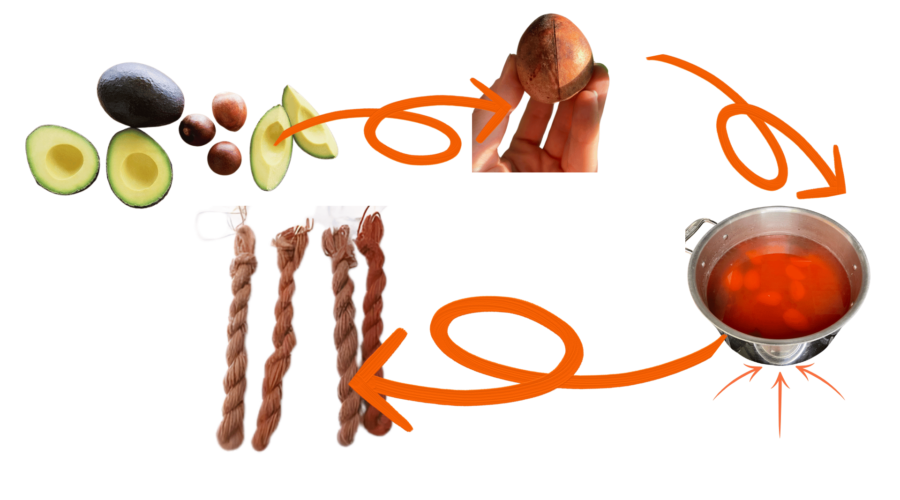Many in the continent eat avocado daily and dispose of the pits. There are various uses for the pit, and one of these is creating a natural dye from avocado pits and skin that can be used for fabric and hair. This is an eco-friendly and chemical-free way to add subtle colour to your hair. Avocado pits can produce a reddish or peachy-pink dye, which may give a slight tint to lighter hair shades or add warmth to darker hair. Here’s how to make and use avocado pit hair dye:
Ingredients :
- 4 to 6 avocado pits and skin (depending on the quantity of natural avocado dye you need) Is often sufficient for shoulder-length hair.
- Water (enough to cover the pits)
- A large pot
- A strainer
- A glass jar or bowl for storage
- Optional: Apple cider vinegar or lemon juice (for enhancing the dye’s longevity)
Instructions To Make Natural Avocado Dye:
1. Prepare the Avocado Pits:
- Clean the avocado pits thoroughly, removing any remaining fruit flesh. You can do this by rinsing them under water and gently scrubbing them.
- Chop the pits into small pieces. A sharp knife can be used to slice them into quarters or smaller chunks. Chopping the pits helps release more pigment during the boiling process.
2. Boil the Pits:
- Place the chopped avocado pits into a large pot and add enough water to cover them completely.
- Bring the water to a boil, then reduce the heat to a simmer. Let the pits simmer for about 1 to 2 hours. As they boil, the water will turn a reddish-pink or peach colour, which is the natural Avocado dye.
- The longer you simmer, the more intense the colour will become.
3. Strain the Dye:
- Once you’ve achieved the desired colour, remove the pot from heat and allow it to cool slightly.
- Strain the liquid into a glass jar or bowl to remove the pit pieces. The liquid is your natural dye.
4. Optional: Enhance Your Natural Avocado Dye:
- If you want to enhance the dye’s longevity, add a tablespoon of apple cider vinegar or lemon juice to the liquid. This can help the colour adhere better to your hair.
5. Apply the Dye:
- Use the dye the next day when it is fully oxidised.
- Wash your hair with a gentle shampoo and towel-dry it until it’s damp.
- Apply the avocado pit dye to your hair using a brush or by pouring it over your hair while standing in the shower or over a sink. Make sure to saturate your hair evenly.
- Massage the dye into your hair and scalp, ensuring that all areas are covered.
6. Let it Sit:
- Leave the natural dye in your hair for about 1 to 2 hours, depending on the desired intensity. You can cover your hair with a shower cap to prevent the dye from dripping.
7. Rinse and Condition if using as natural avocado hair dye:
- After the waiting period, rinse your hair thoroughly with lukewarm water until the water runs clear.
- Apply a conditioner to lock in moisture and smooth your hair. You can also use a leave-in conditioner if you prefer.
8. Dry and Style:
- Let the dye air-dry. The subtle reddish-pink tint should be visible, especially in lighter fabric/hair shades.
Tips For Using This Natural Avocado Dye:
- Both Hair and Fabric can be dyed with this Natural Avocado Dye
- Results may vary depending on your hair type, natural colour, and porosity. The dye is more likely to show up on light or blonde hair. On darker hair, it may add a slight warmth or tint, but the effect will be more subtle.
- Multiple applications may be needed to achieve a stronger colour. Since this is a natural dye, the colour may fade after a few washes, so you can reapply it as needed.
- Test on a small section of hair first to see how the dye reacts with your hair colour and to ensure you like the result.
Conclusion:
Using avocado pits as natural dye is a fun and sustainable way to experiment with colour. While the results may not be as intense as chemical dyes, it’s a gentle option for those looking to add a natural tint to their hair without damaging it. Plus, it’s a great way to use avocado pits that would otherwise be discarded!


